Francesco Mochi, who was born in Montevarchi (near Arezzo), trained in Florence and moved to Rome in 1599. His mentor Duke Mario Farnese secured for him first major commission, which was for the two figures of the Annunciation (1605-8) in the Duomo of Orvieto (see below). He subsequently spent some 17 years working on two major bronze equestrian statues in Piacenza, of Rannuccio Farnese (1612–20) and Alessandro Farnese (1620–29). His other major work is the figure (1629-40) of St Veronica, in St Peter’s. Rome. However, he was overshadowed in the later part of his career by Gianlorenzo Bernini.
Duomo, Orvieto
Francesco Mochi secured four commissions in the Duomo in the period following its 16th century remodelling. All four figures are now exhibited in the ex-church of Sant’ Agostino.
Annunciation (1603-9)
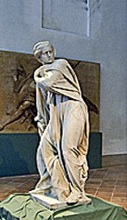
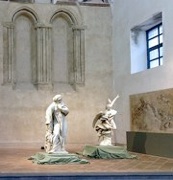
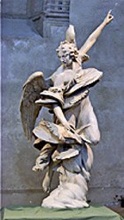
Present arrangement in Sant’ Agostino
In 1603, Duke Mario Farnese secured for his protegé Francesco Mochi a commission to sculpt the figure of St Philip for the series of Apostles in the nave (see below). This was an important opportunity for the young sculptor, since the figure formed part of a series by the leading sculptors of the day. However, before he began, the Opera del Duomo asked him to execute two other, smaller figures, the Archangel Gabriel and the Virgin Annunciate.
The first figure to be delivered (in 1605) was the angel, which Mochi signed and dated by inscription. (The lily that the angel originally carried has been lost). The work was acclaimed for its ethereal quality, for the magnificent technique used to carve the diaphanous drapery, and for the theatricality of the pose. (It is now often regarded as among the earliest in the style that we call the Baroque). Mochi wanted the figure to be placed on the balustrade to the left of the tribune. In this elevated location, bathed in the light from the right, it would impose on the physical space of the congregation in the nave. It was indeed so-positioned for about two years until the Opera del Duomo decided to move it to a less precarious location in the tribune, just inside the balustrade.
The Virgin Annunciate was delivered in 1609. A document from 1612 records that Cardinal Bishop Giacomo Sannesio opposed its installation (perhaps because of the unorthodox pose of the terrified, earth-bound figure and its tight gown). The Opera del Duomo were however satisfied and threatened to seek arbitration from Pope Paul V. There is no record that Paul V was actually consulted, but the figure was installed as a pendant to the angel later in 1612.
The current arrangement of the figures, in the apse of Sant' Agostino (illustrated above), allows them to be lit from the right, as Mochi originally intended.
St Philip (1609-10) and St Thaddeus (1638-44)
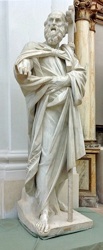
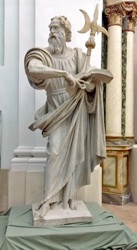
St Philip St Thaddeus
These figures were commissioned from Francesco Mochi to form part of a series of the Apostles in the nave. The figure of St Philip was commissioned shortly before the figure of the Virgin Annunciate (above) was delivered. Francesco Mochi carved it in Orvieto, and delivered it within a year. There followed a protracted wrangle as to its value, and he was not finally paid until 1614, following a determination by the Tribunale della Sacra Rota in Rome.
Francesco Mochi received the commission for the figure of St Thaddeus during a visit to Orvieto in 1638, although it was agreed that he would carve it in Rome. He did not start work on it until 1640 (when work on the St Veronica in St Peter’s ended), and it was not finished until 1644 (the date on its inscription). Damage that it suffered en route from Rome can still be seen.
Perugia
Bust of Marcantonio Eugeni (ca. 1640)
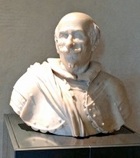
Crucifix (17th century)
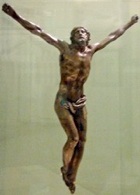
Read more:
M. Favero, “Francesco Mochi. Una Carriera di Scultore”, (2008) Trent
Return to Art in: Orvieto Perugia.
Return to “Foreign” Sculptors in Umbria.



